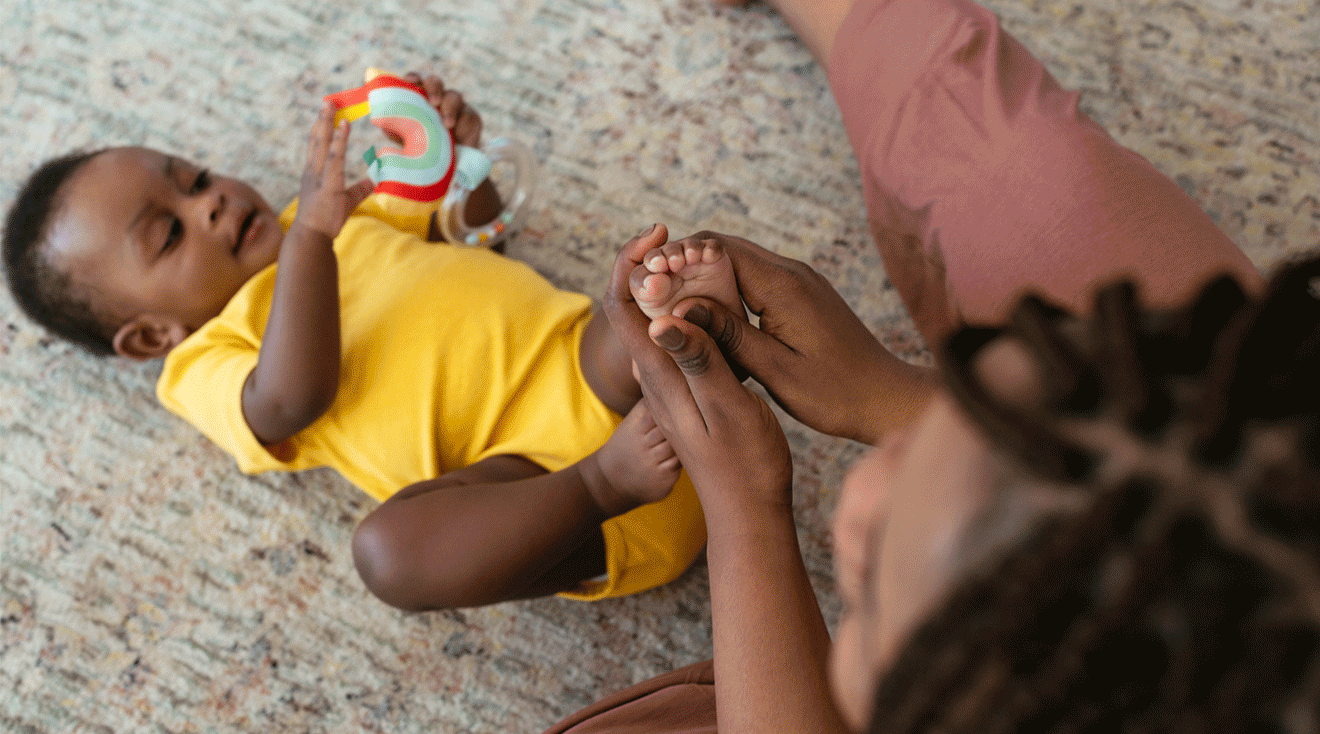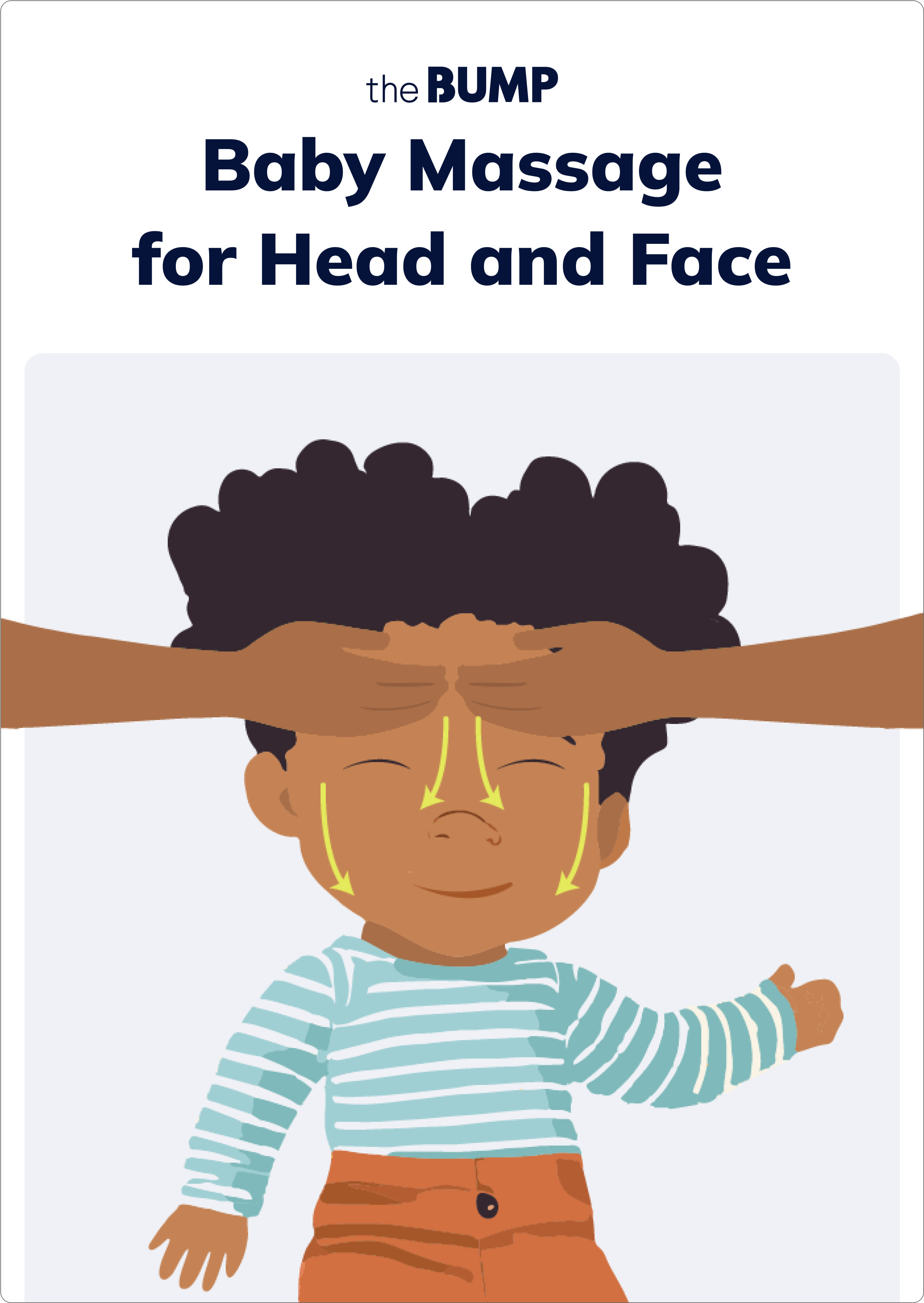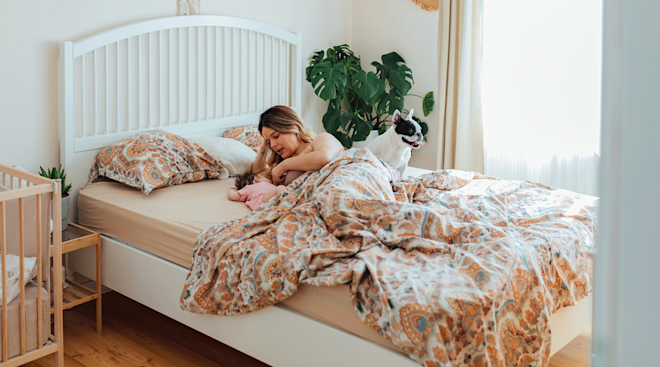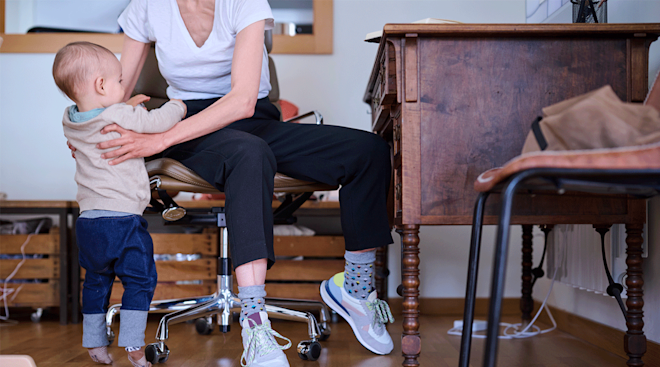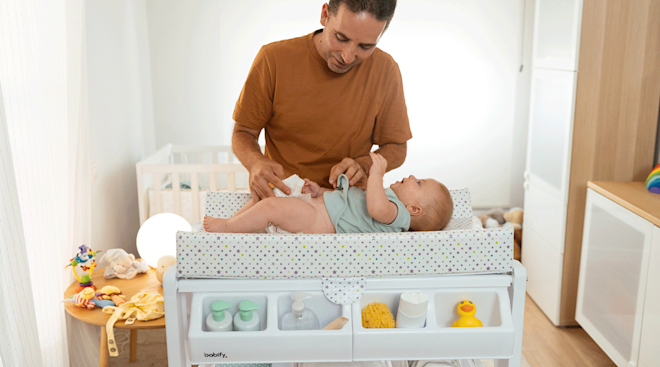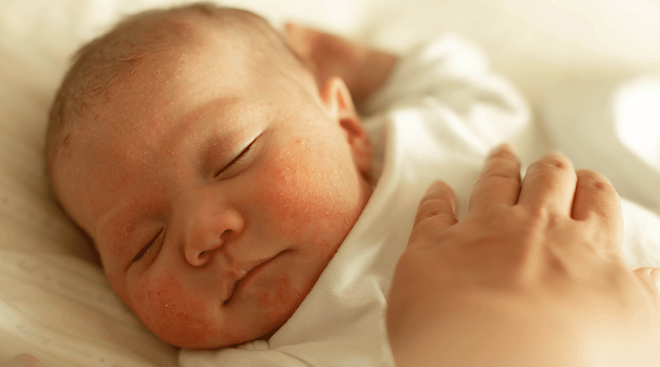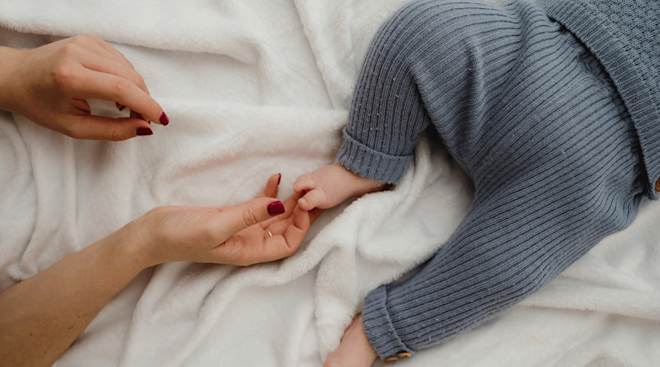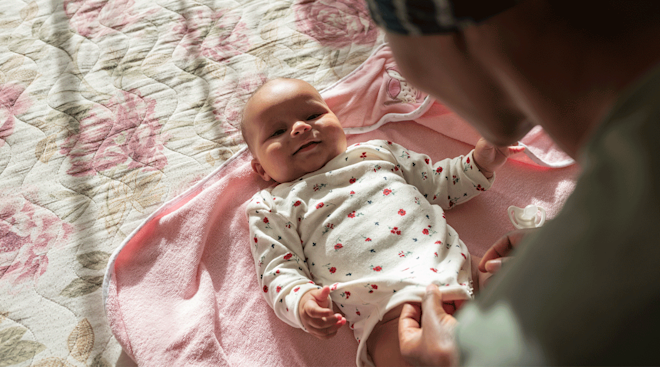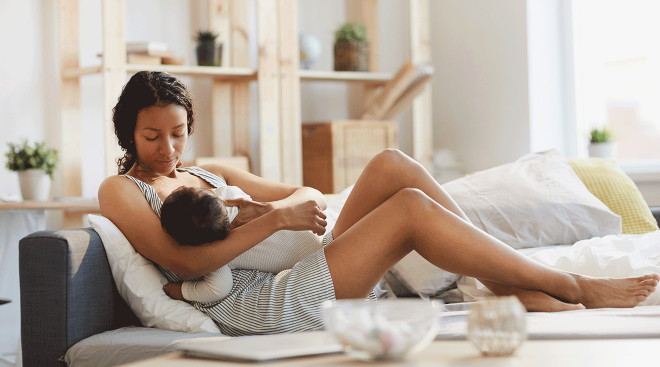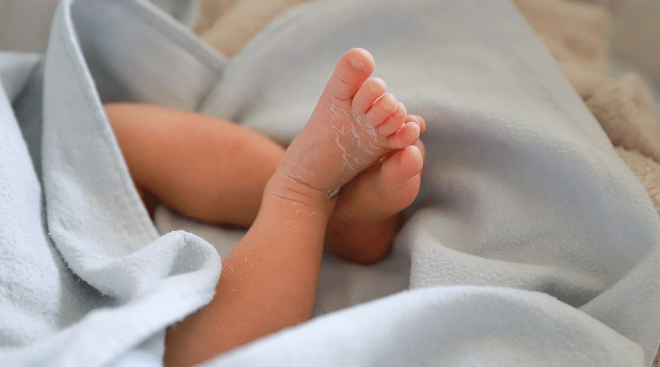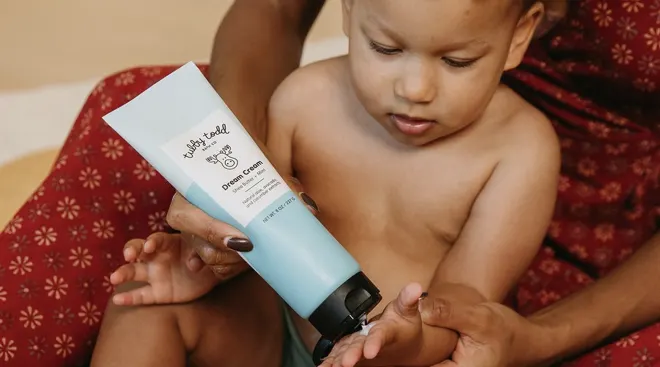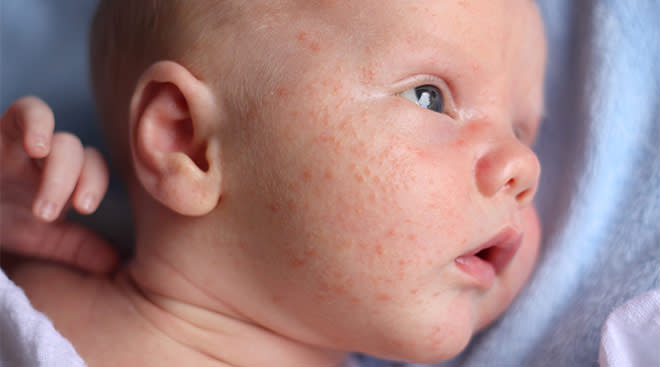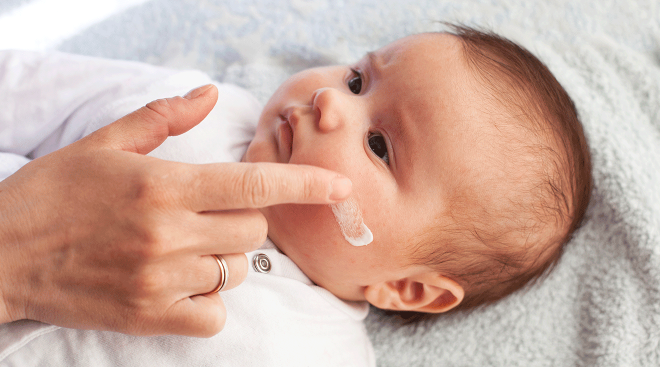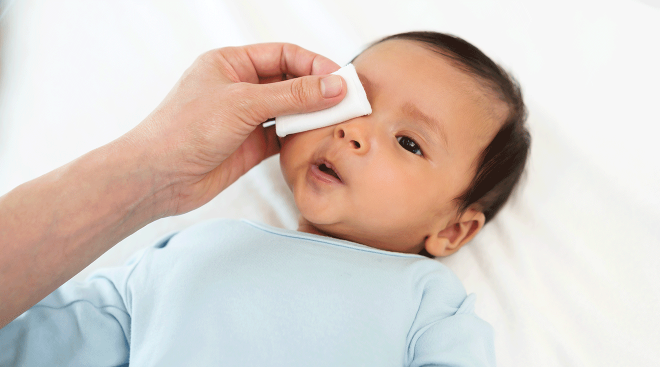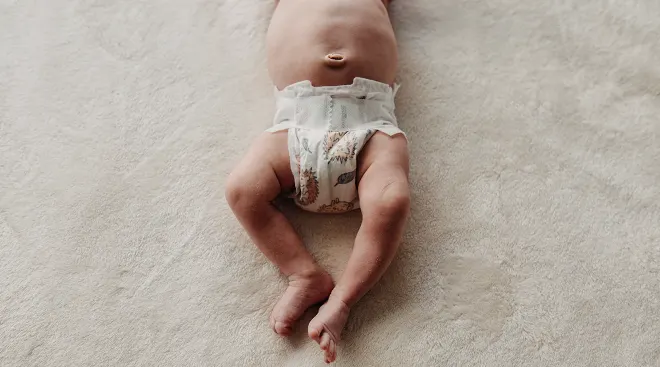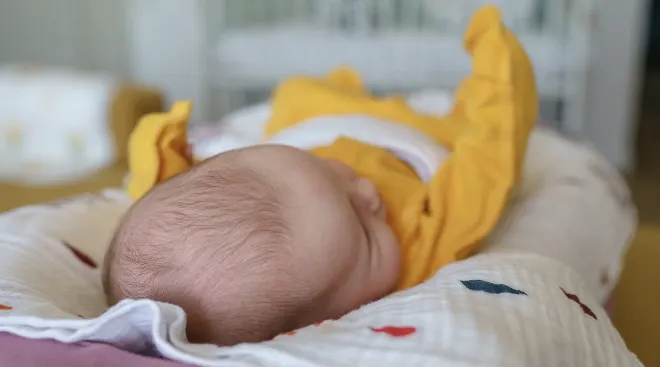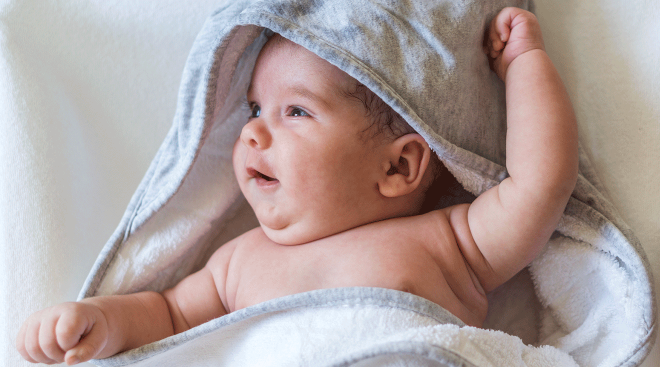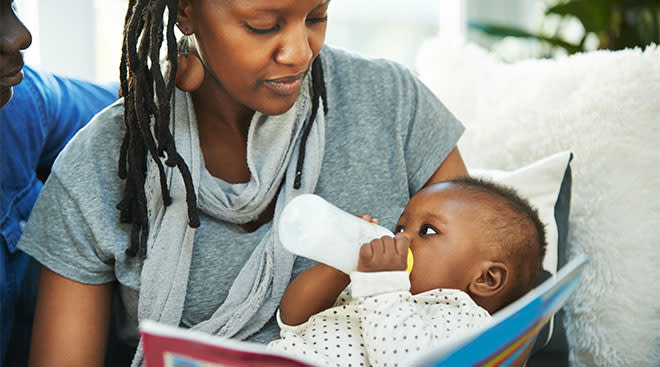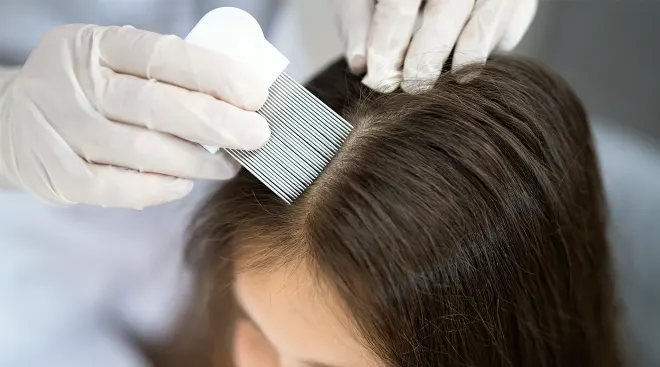The Benefits of Baby Massage
You’ve likely heard about the benefits of skin-to-skin contact. But another wonderful tactile activity to try is baby massage. Experts say it can have major benefits, like reducing baby’s stress (and yours!), improving baby’s sleep and helping their digestion. Below, learn all about infant massage, including tried-and-true tips and techniques.
Experts say that you can try newborn massage as early as birth. “Newborns require so much skin-to-skin contact, and the earlier you start, the more acclimated baby will become to gentle touch,” says Elina Furman, a certified infant massage instructor, author and founder of baby massage brand Kahlmi. She adds that it’s important not to overstimulate a newborn, so very light touch and gentle strokes will get the job done. And, of course, you’ll want to keep an eye out for your little one’s reaction. “If they look fussy and tense up, pause and try again at another time,” advises Furman.
Baby massage can have immediate benefits, such as helping with fussiness, crying and teething-related discomfort, says Furman—but it can also leave a positive long-term impact on baby’s neurodevelopment. “The first three years of baby’s life are so important [to] their future well-being,” she says. “During this time, millions of neural connections create your child’s neurological imprint for the rest of their lives.”
But there are some additional potential benefits of baby massage for baby, according to Furman and the American Academy of Pediatrics (AAP). These include:
- Regulating stress hormones and helping baby feel calmer
- Longer and deeper sleep
- Stronger bonding and attachment
- Less crying and restlessness
- Improved digestion and reduced colic symptoms
- Better motor development and flexibility
- Stronger immunity
Babies aren’t the only ones who can benefit from their massage session. Whitney Casares, MD, MPH, FAAP, a Portland, Oregon-based pediatrician and the founder of Modern Mommy Doc, says that baby massage can benefit both babies and their caregivers by promoting attachment. A recent study found that a group of parents who practiced baby massage reported less stress, a calming feeling and a stronger bond with their infants.
When it comes to baby massage, there’s no need to strive for perfection—it’s all about bonding and connection. “Remember, the point of a baby massage is to connect with your little one, and there’s no perfect way to do a baby massage,” says Casares. That said, there are a few tips and techniques to keep in mind when learning how to give baby a massage.
Baby massage basics
According to the AAP, here’s how to massage different parts of baby’s body:
- Head and face. Start by cupping your hands around baby’s forehead and stroke backward with both hands over the top of their head. Continue slowly moving down along the back of their head, curving down to their jawline until you reach their chin. “Be careful here to avoid soft spots on their head, using a very gentle stroke when massaging,” says Furman. Next, you can rub across their eyebrows a few times for a soothing effect. You can also make small, circular motions on baby’s cheeks.
- Back. Move your hands from baby’s shoulders to their lower back. You can do this during tummy time, when they’re sitting up on their own, in your lap or cradled in your arms.
- Feet. Touch and firmly hold baby’s feet, holding one in each hand—you can also gently clap them together. Hold baby’s ankle in one hand and use your other hand to grasp their foot with your fingers on top and your thumb underneath. Firmly rub up and down along the arch of baby’s foot with your thumb—you can also tug their toes if baby seems to enjoy it.
- Hands. Firmly hold onto baby’s hands. Place your thumb in their palm and hold your fingers on the top side of their hand. Firmly rub your thumb in circular motions to massage baby.
- Shoulders and arms. Rub baby’s shoulders with your fingers while they sit upright. Then, move your hands down their arms.
Baby massage for gas
Many babies struggle with tummy pains from lingering gas stuck in their bowels. And, sometimes, they need a little extra help getting it out. Casares suggests using the upside-down “L” motion technique to move things along:
- Place baby on their back.
- Begin with your hand at the upper right side of baby’s stomach.
- Use medium pressure and slide your hand over to the upper left side of baby’s stomach.
- Slowly move down to the lower left side of their stomach, finishing your upside-down “L” shape.
- Repeat this motion using medium pressure.
Baby massage for constipation
“Babies are born with immature digestive systems, which is why baby massage is so important to release gas and get the bowels moving,” says Furman. She suggests the following steps to help baby with constipation:
- Place baby on their back.
- Start by drawing circles on their belly in a clockwise direction, alternating your hands.
- Repeat this motion for about two to three minutes.
- Hold baby’s legs and gently draw their knees into their chest.
- Lastly, stretch out their legs away from their body to loosen up the stool.
Baby massage for sleep
Yes, massage can help baby sleep better—but it’s important to be consistent. “While one massage isn’t going to turn your fitful sleeper into an overnight sleep sensation, studies show that over time, babies who are massaged become better sleepers,” says Furman. “Right before naptime and nighttime sleep is a great time to wind down baby and to provide a sleep association cue.” Here’s how to do it:
- Place your thumbs on the inner corners of baby’s eyebrows and draw out gently to their temples.
- Next, glide the tip of your finger starting at baby’s forehead down to the bridge of their nose.
- Repeat these sequences five to 10 times, slowing down gradually as baby falls asleep.
Now that you’ve got some basic techniques down, keep in mind that adding baby massage into your routine doesn’t have to be another stressful task on your already busy to-do list. Again, there’s no perfect way to do it. The experts gave their top tips to make this process easy and fun for you and baby:
- Create a calm environment. This could mean dimming the lights, taking baby into a warm room or playing calming music, says Furman. She suggests rubbing your hands together before starting to avoid making baby cold. “If the room is chilly or baby has just been bathed, have a blanket on hand to wrap [them],” Furman suggests.
- Follow baby’s cues. If your infant looks alert and happy, they’re more likely to be receptive to baby massage. If they’re fussy or start crying, stop the massage and try again later. Also, make sure baby isn’t hungry or overtired, says Casares.
- Find the right pressure. Furman suggests using gentle, but firm pressure. If you massage too lightly, this can be ticklish for baby. You want to aim for medium pressure, as if you were lightly pressing dough.
- Use gentle massage oil. Make sure to use a massage oil that’s created for baby’s sensitive skin, advises Furman. “The key is to choose a quality organic massage oil that’s unrefined and edible-grade,” she says. “Never use an undiluted oil, as it can be too strong for baby’s skin.” Always do a patch test on baby’s skin before using an oil, she adds. Furman says you can also use tools like the Kahlmi baby massager wand and how-to cards she’s created.
- Be consistent. “Don’t pressure yourself, but try to create a consistent routine since baby massage has a cumulative effect,” says Furman. “The more you do it, the more benefits baby will experience.” She suggests sneaking in a quick five-minute massage anytime baby seems happy, like when you’re playing with them or during bathtime.
It’s no secret that baby massage can provide plenty of benefits for both you and baby—and that one of the biggest is increasing the connection between you two. “Not only does it help with your baby’s social, neurological and emotional development, it’ll also help you cope with the many challenges of parenthood and develop a deeper bond with and understanding of baby,” says Furman.
Please note: The Bump and the materials and information it contains are not intended to, and do not constitute, medical or other health advice or diagnosis and should not be used as such. You should always consult with a qualified physician or health professional about your specific circumstances.
Plus, more from The Bump:
Whitney Casares, MD, MPH, FAAP, is a pediatrician based in Portland, Oregon, and the founder of Modern Mommy Doc. She is also the author of three books, including Doing it All: Stop Over-Functioning and Become the Mom and Person You're Meant to Be. Casares earned her medical degree from the University of Vermont and completed her pediatrics residency at Stanford University. She also holds a master of public health in maternal and child health from the University of California, Berkeley.
Elina Furman is a certified infant massage instructor, author and founder of baby massage brand Kahlmi. She has over 15 years of experience in the baby product industry and is deeply passionate about spreading awareness on the importance of baby massage. As a baby massage expert, she has led education for brands such as Lovevery, Legendairy Milk and Mama Glow.
Healthy Children (American Academy of Pediatrics), The Benefits of Baby Massage, January 2024
Nursing Open, Lessons Learned from Child Health Care Nurses' Experiences of Teaching Infant Massage Groups: A Qualitative Interview-Based Study, December 2022
Learn how we ensure the accuracy of our content through our editorial and medical review process.
Navigate forward to interact with the calendar and select a date. Press the question mark key to get the keyboard shortcuts for changing dates.

































